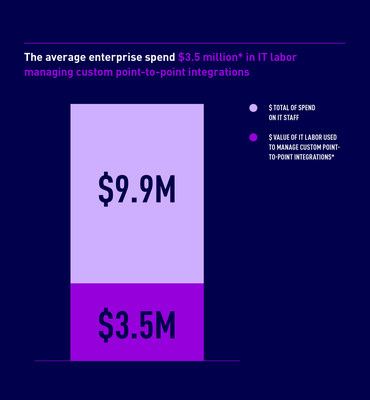Only 37% of IT teams were able to complete all the projects asked of them last year, and are asked to complete 30% more projects this year
Data silos continue to be a challenge year-over-year for 90% of organizations
Four out of five organizations recognize the need to empower business users to easily integrate apps and data to deliver connected experiences and drive innovation, faster
PR Newswire
SAN FRANCISCO
,
March 30, 2021
/PRNewswire/ —
MuleSoft
, provider of the world’s #1 integration and API platform, today reported that integration challenges continue to be a major roadblock for digital transformation initiatives.
MuleSoft’s 2021 Connectivity Benchmark Report
found that IT teams are spending over a third of their time on integration projects, and custom integrations are costing large enterprises on average
$3.5 million
* each in annual labor. As digital initiatives accelerate,
integration
has emerged as a critical factor in determining the success and speed of digital transformation across industries.
“Organizations across industries have experienced a rapid shift toward interacting with customers and employees through digital channels,” said
Brent Hayward
, CEO, MuleSoft. “Although most organizations are prioritizing digital initiatives, such as launching an e-commerce platform or increasing worker productivity, the research shows that data silos continue to hinder their capabilities to deliver on these key initiatives. Companies that empower their IT and business teams to easily integrate apps and data will be able to unlock the full capacity within their organization to drive innovation at scale and gain competitive edge.”
Based on a global survey of 800 CIOs and IT decision makers, the 2021 Connectivity Benchmark Report also highlights new challenges and opportunities for businesses as they navigate a digital-first world:
Increased demands pressuring businesses to deliver digital faster
The last 12 months have seen a profound shift in the way people work and how organizations operate. Employees and customers alike want seamless digital experiences and expect organizations to deliver on these experiences, faster.
-
New initiatives to enable success from anywhere:
This past year, organizations relied on IT to support a rapid shift to remote working and the need for increased productivity and efficiency. Migrating apps to the cloud (51%), enabling remote working (48%) and automating business processes (47%) were cited as the key initiatives that organizations are focusing on for 2021. They were closely followed by using IT to create a safe working environment, modernizing legacy systems, and integrating SaaS apps (each 45%). -
When demand surpasses supply:
Demands on IT have increased massively. Organizations asked IT to deliver on average 30% more projects this year, a number that is constantly growing year-over-year (315 projects in 2021 compared to 242 projects in 2020). Only 37% of respondents say they were able to deliver all IT projects last year (compared to 41% the previous year). -
Go digital or get left behind:
More than three-quarters (77%) of organizations say a failure to complete digital transformation initiatives will impact revenues over the next year. -
The cost of “keeping the lights on”:
IT is spending over two-thirds of their time (68%) on running the business, leaving little time for innovation and development of new projects.
Integration challenges hold businesses back
Data silos remain a challenge for 90% of organizations (unchanged since last year’s report). And almost 9 in 10 respondents point to integration challenges as a blocker to delivering on digital transformation. If this trend continues, it risks stalling key business initiatives for many organizations. Integration will continue to be a major area of focus as organizations look to connect and derive more value from their new and existing apps and data.
-
So many applications, so little integration:
On average, organizations use 843 individual applications. However, only 29% of these applications are integrated (a slight increase from 28% in the previous year), highlighting huge potential for organizations to drive change and deliver more connected experiences. -
Connected customer experiences remain a challenge to achieve:
Only 18% of organizations integrate end-user experiences across all channels, with almost half (48%) stating they have found it difficult to do so. However, for those organizations that have successfully integrated end-user experiences, increased customer engagement (53%), business transformation (53%) and innovation (50%) have been the major benefits. -
Data-related roles have the biggest integration needs:
Outside of IT, data science (47%), business analyst (42%) and finance (42%) are the roles with the biggest integration needs. This further highlights how business users and initiatives with a data focus are prime candidates for integration support.
Empowering enterprise-wide innovation
Organizations recognize the strategic importance of integration to help achieve revenue goals and deliver connected experiences faster. To lessen the integration burden on IT and drive innovation and productivity, organizations are looking to drive reuse of existing integrations and empower the wider business to connect apps and data.
-
Integration and API strategy is being led from the top:
More than two-thirds (69%) of organizations say they have a top-down approach to integration and API strategy. This is an increase from 63% last year, highlighting the growing importance of integration to achieving business goals. -
API reuse is a massive area of opportunity:
While most organizations (96%, up from 80% last year) are using APIs to build integrations and deliver new projects, best practices around API reuse remain an area of improvement. The reuse of code,
APIs
, and best practice templates has plateaued over the last two years. Organizations have on average 42% of such internal assets and components available for reuse. This is a massive area of opportunity as organizations leveraging APIs experience increased productivity (59%), self-service (48%) and increased innovation (46%).
-
Enabling all business users:
Four in five organizations recognize the need to make data and integration accessible to business users to increase productivity, deliver connected experiences and drive innovation. Over a third (36%) of organizations say they have a mature approach to enabling non-IT users to easily integrate apps and data sources through APIs. Another 44% say they are in the process of developing plans, further highlighting that organizations are looking to empower business users with integration.
Additional information:
-
For deeper insight into how organizations around the world are driving their digital transformation initiatives, download the
2021 Connectivity Benchmark Report
. -
Register to virtually attend
MuleSoft CONNECT
, the world’s leading integration event, to learn best practices for solving the business challenges and trends that are shaping the future of IT.
Methodology
For the sixth-annual Connectivity Benchmark Report, MuleSoft, in partnership with
Vanson Bourne
, surveyed 800 IT leaders from global enterprises. The goal was to uncover how much value businesses actually gain from digital transformation, and to understand IT leaders’ most successful strategies for achieving digital transformation goals. The online survey was conducted between
December 2020
and
January 2021
across
the United States
, the
United Kingdom
,
France
,
Germany
,
Netherlands
,
Australia
,
Singapore
,
Hong Kong
and
Japan
. Only suitable candidates participated in the survey and were verified by using a rigorous, multi-level screening process. All respondents work at an enterprise organization in the public or private sector with at least 1,000 employees and hold a managerial position or above in an IT department.
*
Survey respondents stated on average they spent
$9,870,901
on IT staff (both on employee salaries and external contractors) over the last 12 months.
Cumulatively survey respondents stated on average their IT teams were spending 35.55% of their time designing, building, and testing custom integrations.
$9,870,901
x 35.55% =
$3,509,105.31
About MuleSoft, a Salesforce company
MuleSoft, provider of the world’s #1 trusted integration and API platform, empowers any company to quickly unlock and integrate their apps and data to create connected experiences, faster. For more information, visit:
https://www.mulesoft.com
.
About Salesforce
Salesforce, the global CRM leader, empowers companies of every size and industry to digitally transform and create a 360° view of their customers. For more information about Salesforce (NYSE: CRM), visit:
www.salesforce.com
.
MuleSoft is a registered trademark of MuleSoft, Inc., a Salesforce company. All other marks are those of respective owners.
![]()
View original content to download multimedia:
http://www.prnewswire.com/news-releases/study-reveals-integration-challenges-threaten-digital-transformation-with-organizations-spending-on-average-3-5-million-on-custom-integration-labor-costs-301257870.html
SOURCE MuleSoft










